The Pallet Report: Pallets help optimize operations, protect products and organize space
Modern’s annual reader survey shows just how critical the pallet continues to be in the smooth running of warehouses and DCs nationwide.
Vital parts of any warehouse or DC, pallets have long been a mainstay in the logistics environment, helping to drive the transport, storage and delivery of goods around the clock. And while materials handling equipment, software and applications have recently made technology advances, the pallet itself hasn’t undergone much transformation over the last few years.
Charged with helping companies fit the maximum number of products on a transportable platform that keeps items clean and protected, pallets can be new or used, purchased or rented, and made of wood, plastic, metal or aluminum. And while they’ve always enabled speedy loading and unloading, pallets are particularly vital in a business world where smaller order sizes, high order velocities and e-commerce are all pushing companies to find ways to work smarter, better and faster.
For our annual survey of readers who use pallets, Peerless Research Group (PRG) surveyed subscribers of Modern along with a sample of recipients of our e-newsletters. We received 274 qualified responses from readers employed at a location that uses pallets.
The selection process
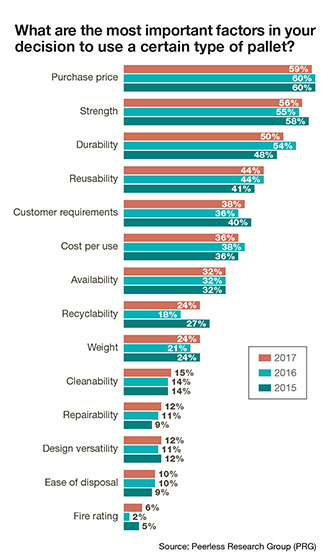 When selecting pallets, most readers consider purchase price (59%), strength (56%), durability (50%) and reusability (44%) before making a choice. These factors have remained consistent from 2016 to 2017. The majority of companies are using wood pallets (93%), while 45% use plastic, 18% use wood composite, and 10% are using metal pallets. The alternatives to wood pallets (i.e., plastic, composite and metal) have grown in popularity over 2016, with plastic pallets seeing the most significant uptick (38% in 2016 to 45% in 2017).
When selecting pallets, most readers consider purchase price (59%), strength (56%), durability (50%) and reusability (44%) before making a choice. These factors have remained consistent from 2016 to 2017. The majority of companies are using wood pallets (93%), while 45% use plastic, 18% use wood composite, and 10% are using metal pallets. The alternatives to wood pallets (i.e., plastic, composite and metal) have grown in popularity over 2016, with plastic pallets seeing the most significant uptick (38% in 2016 to 45% in 2017).
When buying wood pallets, 62% of respondents say they prefer used or core pallets, 56% prefer new pallets, and 10% are using pallet pools. The latter finds companies either renting pallets from one of the various pallet poolers (e.g., CHEP, PECO or iGPS), which are responsible for retrieving, repairing and redistributing their pallets, or managing their own pool of recycled pallets. Although these pooling services remain a viable option, few readers say they are using them at this point.
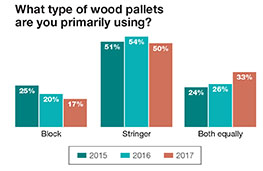 When asked about their experiences with used pallets, most readers expressed “poor quality” and “lack of availability” as their main issues with this option. This feedback has remained constant over the last two years. Forty-seven percent of companies have not experienced any issues—or don’t anticipate running into problems—with used pallets, but slightly more than half (53%) have experienced issues or anticipate them.
When asked about their experiences with used pallets, most readers expressed “poor quality” and “lack of availability” as their main issues with this option. This feedback has remained constant over the last two years. Forty-seven percent of companies have not experienced any issues—or don’t anticipate running into problems—with used pallets, but slightly more than half (53%) have experienced issues or anticipate them.
Seeking alternatives
Even as alternative materials make their way into the pallet landscape, wood continues its reign as the material of choice. Forty-seven percent of readers are using the same number of pallets that they were a year ago while 38% are using more. Just 15% of readers are using fewer wood pallets than they were 12 months ago, but only 12% indicated they were using fewer wood pallets than last year.
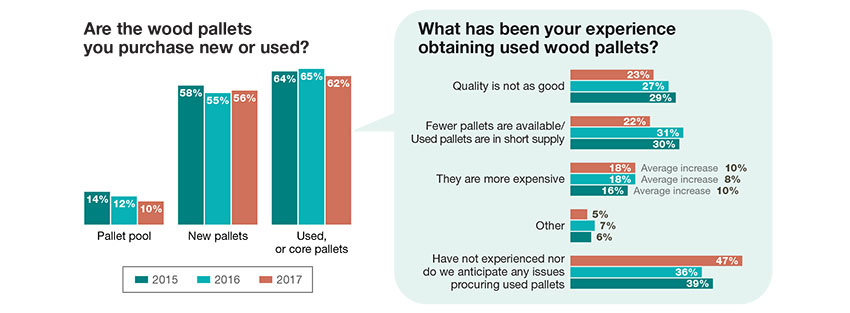
Currently, half of Modern’s readers are using stringer pallets, 17% prefer block, and 33% use an equal number of stringer and block types. The use of block pallets has seen a steady decrease to a current 17% of readers (down from 25% in 2015 and 20% in 2016). In terms of preferred pallet sizes, most readers (65%) are using 48 x 40-inch while 30% prefer 48 x 48-inch pallets. Although these larger pallets are still the most popular over the years, smaller pallet sizes have seen a gradual increase from 2015 to 2017.
Use of the 36 x 48-inch pallet has increased from 0% in 2015 to 13% in 2017, while 36 x 36-inch has increased to 15% (from only 9% in 2016). Usage of half-pallets (24 x 20-inch) grew to 11% in 2017 from 5% in both 2016 and 2015. Smaller orders and need for better optimization of storage space could be possible reasons for these steady increases in smaller pallets.
Up-and-coming materials
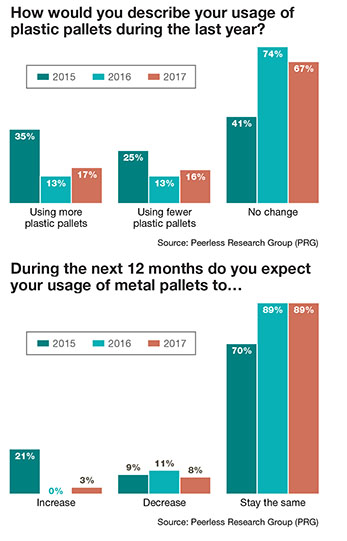 Both plastic and metal are popular pallet material choices for specific types of companies and/or shipments. For 2017, about 67% of readers are using the same number of plastic pallets as they were the previous year. And, 16% are using fewer plastic pallets and another 17% are using more. When asked if they expect their use of plastic pallets to grow in the next 12 months, 15% of readers expect an increase, while 9% expect a decrease, and 73% anticipate usage to remain the same. Plastic pallet usage appears to be up slightly over 2016, but is still lower than it was the prior year, when 35% of readers were choosing this option.
Both plastic and metal are popular pallet material choices for specific types of companies and/or shipments. For 2017, about 67% of readers are using the same number of plastic pallets as they were the previous year. And, 16% are using fewer plastic pallets and another 17% are using more. When asked if they expect their use of plastic pallets to grow in the next 12 months, 15% of readers expect an increase, while 9% expect a decrease, and 73% anticipate usage to remain the same. Plastic pallet usage appears to be up slightly over 2016, but is still lower than it was the prior year, when 35% of readers were choosing this option.
Used to transport heavy goods for air freight and at-sea storage, metal pallets made from steel or aluminum may be a costlier choice, but remain a popular option for companies that use heavy payloads and that want pallets that are rackable, fireproof and/or sanitary. According to the survey, 89% of readers plan to maintain their current metal pallet usage, which has stayed consistent since 2016. And, 8% of companies expect to decrease their use of metal (versus 11% in 2016) and 3% of respondents plan to acquire more metal pallets.
Meeting customer demands
According to readers, 17% of customers have demanded changes in pallet usage over the last 12 months, with 83% saying they’ve fielded no such demands. Respondents say that customers are mostly requiring them to switch to stringer pallets (32%), while 25% are in need of more block pallets (down from 42% in 2016).
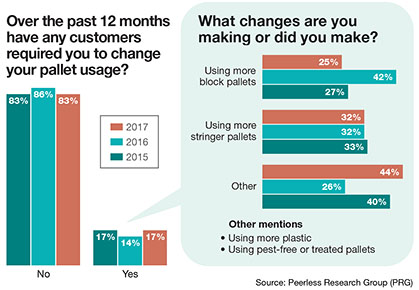 As other types of pallets gain in popularity, 44% of “other responses” included alternatives like plastic pallets and pest-free or treated pallets. The types of businesses requiring those changes include manufacturers (32%, down from 37% last year), wholesalers (19% versus 33%), and retailers (22%, down from 27%). For 2017, 10% of readers are using pallet rental companies, up from 6% in 2016, while 8% are using some other type of pallet retrieval or recovery system. The latter has remained consistent since 2016.
As other types of pallets gain in popularity, 44% of “other responses” included alternatives like plastic pallets and pest-free or treated pallets. The types of businesses requiring those changes include manufacturers (32%, down from 37% last year), wholesalers (19% versus 33%), and retailers (22%, down from 27%). For 2017, 10% of readers are using pallet rental companies, up from 6% in 2016, while 8% are using some other type of pallet retrieval or recovery system. The latter has remained consistent since 2016.
The majority of readers (47%) say they aren’t likely to use such a system over the next 12 months and 26% say this move is “not very likely.” Fifty-eight percent of respondents use CHEP (up from 32% last year) for pallet management. Currently, 37% of companies are using self-managed systems, while an equal number of respondents (21%) use either PECO or iGPS.
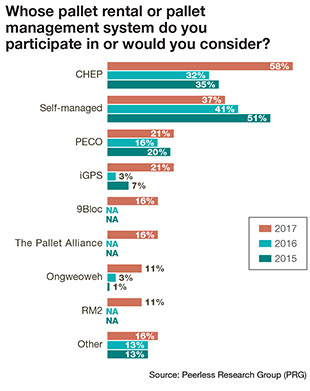 When asked if they’ve evaluated or considered a system or solution for creating or managing their own pallet pools, 24% of readers say “yes” and 76% say “no.” Just 8% say they’d want to hear more about pallet pooling service options, and 40% aren’t interested in such services.
When asked if they’ve evaluated or considered a system or solution for creating or managing their own pallet pools, 24% of readers say “yes” and 76% say “no.” Just 8% say they’d want to hear more about pallet pooling service options, and 40% aren’t interested in such services.
Industry shifts
Working mostly with national retailers like Walmart and Costco, and major supermarket chains like Publix and Safeway, readers are shipping domestically (45%), internationally (3%), and a mix of both (52%). Outside of the United States, the most popular shipping destinations include Canada (82%), Mexico/South America/Caribbean (73%) and China/Japan/Southeast Asia (60%). These percentages have remained stable over the last two years.
For international shipments, readers say they take steps such as having their pallets treated (49%), using wood pallets they own (19%), and using plastic, corrugated, pressed wood, or metal pallets rather than wood (19%). Sixteen percent of companies say their pallet usage strategy doesn’t change when shipping overseas.
Modern also asked readers to give their thoughts on new pallet trends, including retailers’ anticipated preference shift from stringer pallets to block pallets. Forty-six percent of readers say they haven’t made any changes in that direction and 8% have. Another 22% say they’re “unsure what they’ll do” about a move over to block pallets. When asked if they will use a pallet leasing or a pooling management provider to obtain block pallets—should the shift from stringer pallets take place—50% of readers say they will and 50% say they won’t.
Outside help
For now, 15% of respondents are using (or, have used in the past) a third-party service to help them better understand the pallet and transport packaging combination (i.e., stretch wrap, shrink wrap or banding) that’s best suited for their operations. This interest level increased from 9% in 2016, with 27% of readers at least “somewhat interested” (or more) in using a third-party service (42% aren’t interested in it at all).
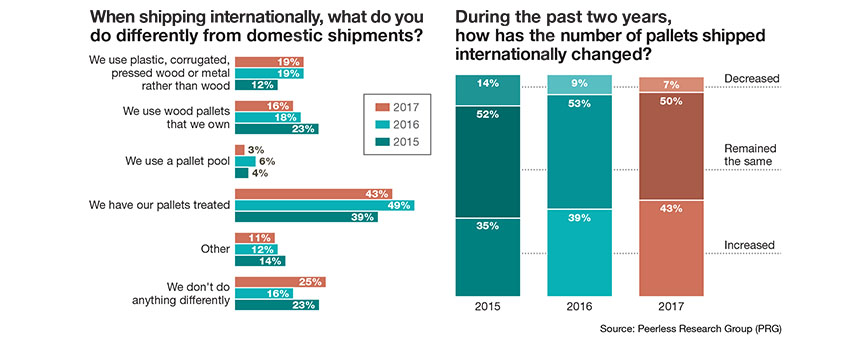
In terms of value-added services, pallet providers are offering their customers vendor-managed pallet inventory/just-in-time delivery (33%); on-site recycling and reclamation process management (30%); and on-site crate assembly and delivery to the manufacturing line (7%). After peaking in 2015, these services have either been offered by a few providers, or readers are not aware that their pallet providers are offering these solutions.
As pallets continue to maintain their popularity in warehouses and DCs nationwide, and as more companies strive to optimize valuable space and meet the rigorous demands of the e-commerce world, we’ll surely see even more firms using pallets as tools for gaining additional storage capacity, protecting and organizing products, and increasing overall productivity.
You can download the full report here.

Article Topics
Shipping Pallets News & Resources
Two voices of reason on pallet materials PLA Solutions Video - Stay on Top of It All Pallet recycler and services company PLA appoints Steve Clark as CEO Cobot as key ingredient for palletizing efficiency CHEP appoints Xavier Garijo to newly created CEO Americas position Pallet company Kamps announces executive team changes PLA names Jenny Bedard as new CFO More Shipping PalletsLatest in Materials Handling
Beckhoff USA opens new office in Austin, Texas Manhattan Associates selects TeamViewer as partner for warehouse vision picking ASME Foundation wins grant for technical workforce development The (Not So) Secret Weapons: How Key Cabinets and Asset Management Lockers Are Changing Supply Chain Operations MODEX C-Suite Interview with Harold Vanasse: The perfect blend of automation and sustainability Consultant and industry leader John M. Hill passes on at age 86 Registration open for Pack Expo International 2024 More Materials HandlingAbout the Author
Subscribe to Materials Handling Magazine

Find out what the world's most innovative companies are doing to improve productivity in their plants and distribution centers.
Start your FREE subscription today.
April 2024 Modern Materials Handling

Latest Resources












